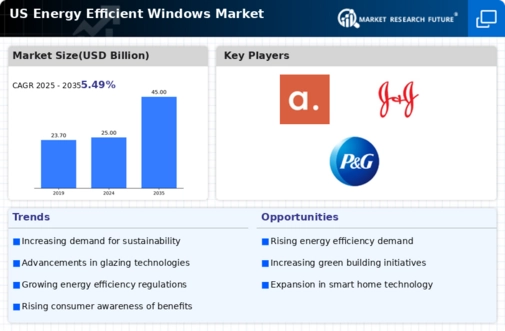Rising Energy Costs
The escalating costs of energy in the US have become a pivotal driver for the energy efficient-windows market. As homeowners and businesses seek to mitigate their energy expenses, the demand for energy efficient windows has surged. In recent years, energy prices have increased by approximately 15%, prompting consumers to invest in solutions that promise long-term savings. Energy efficient windows not only reduce heating and cooling costs but also enhance property value. This trend is particularly pronounced in regions with extreme weather conditions, where energy consumption peaks. Consequently, the energy efficient-windows market is experiencing robust growth as consumers prioritize investments that yield financial benefits while contributing to sustainability.
Environmental Regulations
Stringent environmental regulations in the US are significantly influencing the energy efficient-windows market. Government initiatives aimed at reducing carbon emissions and promoting energy conservation have led to increased scrutiny of building materials and practices. The implementation of the Energy Star program, which certifies energy efficient products, has encouraged manufacturers to innovate and improve their offerings. As a result, the market is witnessing a shift towards windows that meet or exceed these regulatory standards. Compliance with these regulations not only enhances marketability but also aligns with the growing consumer preference for eco-friendly products. This regulatory landscape is likely to continue shaping the energy efficient-windows market in the coming years.
Technological Innovations
Technological advancements in window manufacturing are propelling the energy efficient-windows market forward. Innovations such as low-emissivity (Low-E) coatings, triple glazing, and advanced frame materials have enhanced the thermal performance of windows. These technologies can reduce heat transfer by up to 50%, making homes and commercial buildings more energy efficient. Furthermore, the integration of smart technologies, such as automated shading systems, is gaining traction. These innovations not only improve energy efficiency but also offer convenience and comfort to users. As manufacturers continue to invest in research and development, the energy efficient-windows market is poised for further growth, driven by the demand for high-performance products.
Growing Awareness of Sustainability
The increasing awareness of sustainability among consumers is significantly impacting the energy efficient-windows market. As environmental concerns become more prevalent, consumers are actively seeking products that align with their values. Energy efficient windows are perceived as a sustainable choice, contributing to reduced energy consumption and lower carbon footprints. This shift in consumer behavior is reflected in market trends, with a notable increase in demand for eco-friendly building materials. Additionally, educational campaigns and initiatives promoting energy efficiency are further enhancing consumer knowledge. As awareness continues to grow, the energy efficient-windows market is expected to benefit from a more informed consumer base that prioritizes sustainability in their purchasing decisions.
Increased Home Renovation Activities
The surge in home renovation activities across the US is acting as a catalyst for the energy efficient-windows market. Homeowners are increasingly opting to upgrade their windows as part of broader renovation projects aimed at enhancing energy efficiency and aesthetic appeal. According to recent data, approximately 40% of homeowners plan to undertake renovations within the next year, with energy efficiency being a primary consideration. This trend is particularly evident in older homes, where outdated windows contribute to energy loss. As homeowners recognize the benefits of energy efficient windows, including lower utility bills and improved comfort, the market is likely to expand as renovation activities continue to rise.














Leave a Comment